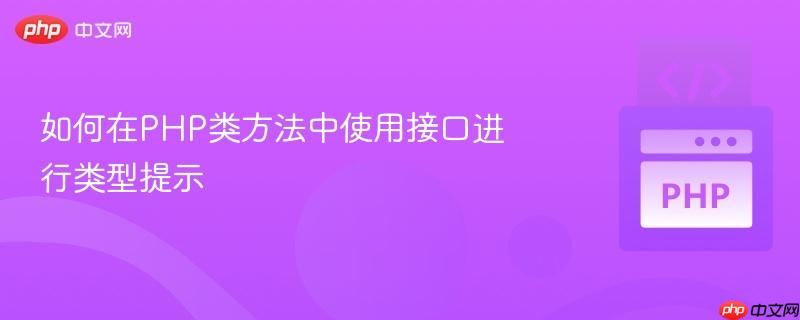
本文详细介绍了如何在PHP类方法中通过接口进行参数类型提示。通过定义接口作为契约,并创建具体类实现该接口,我们可以确保传递给方法的对象符合预期的行为规范。这不仅提升了代码的健壮性和可维护性,还实现了多态性,使得方法能够接受任何实现了指定接口的对象,从而增强了代码的灵活性和可扩展性。
在PHP面向对象编程中,接口(Interface)提供了一种定义类行为规范的强大机制。当一个类方法需要一个特定类型的参数时,我们可以使用接口作为类型提示,而不是具体的类。这种做法带来了极大的灵活性和解耦,是实现依赖倒置原则(Dependency Inversion Principle)的关键。
假设我们有一个Client类,其中包含一个execute方法。此方法需要一个参数来执行其逻辑,并且这个参数必须能够提供一些特定的行为,例如获取请求方法和路径。为了强制任何传递给execute方法的对象都具备这些行为,我们可以定义一个接口。
考虑以下接口和类定义:
立即学习“PHP免费学习笔记(深入)”;
interface RequestInterface
{
/**
* 获取请求方法(例如:GET, POST)
* @return string
*/
public function getMethod();
/**
* 获取请求路径
* @return string
*/
public function getPath();
}
class Client
{
/**
* 执行请求
* @param RequestInterface $request 实现了RequestInterface接口的请求对象
* @return mixed
*/
public function execute(RequestInterface $request)
{
// 在这里可以安全地调用 $request->getMethod() 和 $request->getPath()
// 因为任何实现了 RequestInterface 的对象都保证有这些方法
echo "执行请求:方法 - " . $request->getMethod() . ", 路径 - " . $request->getPath() . "\n";
return 0; // 示例返回值
}
}在上面的Client类中,execute方法明确声明它需要一个RequestInterface类型的参数。这意味着任何传递给此方法的对象都必须实现RequestInterface接口。

BIWEB 门户版几经周折,最终与大家见面了。BIWEB门户版建立在ArthurXF5.8.3底层上,有了更加强大的功能。 BIWEB WMS v5.8.3 (2010.1.29) 更新功能如下: 1.修正了底层getInfo方法中的调用参数,做到可以根据字段进行调用。 2.修正了栏目安装和卸载后,跳转链接的错误。 3.修正所有栏目分类系统,提交信息页面错误。 4.新增后台删除信息后仍停留原分
 0
0

要成功调用Client::execute()方法,我们首先需要创建一个具体的类,该类实现RequestInterface接口。这个具体的类将提供接口中定义的所有方法的实际实现。
class MyRequest implements RequestInterface
{
private $method;
private $path;
public function __construct(string $method, string $path)
{
$this->method = $method;
$this->path = $path;
}
/**
* @return string
*/
public function getMethod()
{
return $this->method;
}
/**
* @return string
*/
public function getPath()
{
return $this->path;
}
}现在,我们有了MyRequest类,它完全符合RequestInterface的契约。因此,我们可以创建MyRequest的实例,并将其作为参数传递给Client::execute()方法。
下面是一个完整的示例,展示了如何定义接口、实现接口,并在类方法中使用接口进行类型提示:
<?php
// 1. 定义接口
interface RequestInterface
{
/**
* 获取请求方法(例如:GET, POST)
* @return string
*/
public function getMethod();
/**
* 获取请求路径
* @return string
*/
public function getPath();
}
// 2. 实现接口的具体类
class MyRequest implements RequestInterface
{
private $method;
private $path;
public function __construct(string $method, string $path)
{
$this->method = $method;
$this->path = $path;
}
public function getMethod()
{
return $this->method;
}
public function getPath()
{
return $this->path;
}
}
// 3. 包含接口类型提示的类
class Client
{
public function execute(RequestInterface $request)
{
echo "Client::execute() 方法被调用。\n";
echo "请求方法: " . $request->getMethod() . "\n";
echo "请求路径: " . $request->getPath() . "\n";
// 实际业务逻辑...
return 0; // 示例返回值
}
}
// 4. 使用示例
$myRequest = new MyRequest('GET', '/api/users');
$client = new Client();
$result = $client->execute($myRequest);
var_dump($result); // 输出: int(0)
// 尝试使用未实现接口的类,将会导致类型错误
// class AnotherClass {}
// $anotherObject = new AnotherClass();
// $client->execute($anotherObject); // 这将抛出一个 TypeError
?>运行上述代码,你将看到Client::execute()方法成功地接收并处理了MyRequest对象,并输出了预期的信息。如果尝试传递一个没有实现RequestInterface接口的对象,PHP将抛出一个TypeError,这正是类型提示所提供的类型安全保障。
总之,在PHP类方法中使用接口进行类型提示是一种推荐的最佳实践,它有助于构建健壮、灵活且易于维护的面向对象应用程序。通过遵循接口定义的契约,开发者可以确保代码的互操作性,并充分利用多态性和依赖倒置带来的优势。
以上就是如何在PHP类方法中使用接口进行类型提示的详细内容,更多请关注php中文网其它相关文章!

PHP怎么学习?PHP怎么入门?PHP在哪学?PHP怎么学才快?不用担心,这里为大家提供了PHP速学教程(入门到精通),有需要的小伙伴保存下载就能学习啦!

Copyright 2014-2025 https://www.php.cn/ All Rights Reserved | php.cn | 湘ICP备2023035733号